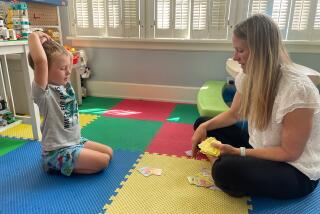Coming Apart
- Share via
There was a time not long ago, in the “perfect” world of the 1950s, when every American family at the dinner table was expected to resemble a Norman Rockwell painting and any marriage that ended in divorce was considered a disgrace. Divorce, declared sociology textbooks of the time, was a public acknowledgment of failure, and a man or woman who was divorced often became an object of scorn and gossip in the neighborhood.
But in a scant 50 years, the social pendulum has swung the other way in dramatic fashion. Today nearly half of all American marriages don’t last, which is more than twice the rate of other industrialized nations. Between 1970 and the mid-1990s, the number of divorced Americans grew from 4.3 million to 17.4 million, causing various institutions to issue gloomy pronouncements.
“At no time in history, with the possible exception of Imperial Rome, has the institution of marriage been more problematic than it is today,” a demographer says in a report published by the Council on Families in America. “In a high-divorce society, not only are more unhappy marriages likely to end in divorce, but in addition more marriages are likely to become unhappy.”
Various scholars and think tanks have spent time and endowments hunting for explanations behind this growth in the number of divorces--sexual liberation in the ‘60s, new attitudes about cohabitation versus marriage and no-fault divorce laws--but few have paused to consider another serious and often overlooked aspect of divorce: the children caught in the middle.
And this is why Judith Wallerstein’s “The Unexpected Legacy of Divorce,” a purportedly definitive study of the long-term effects of divorce on children, is an anxiously awaited study. Although it offers many glimpses into the lives of children of divorce, it delivers less than it promises. Wallerstein believes that society should protect children who are involuntarily enmeshed in divorce. But she provides no recipe for that protection and suggests that none exists.
Wallerstein and her colleagues studied the children of 60 middle-class Marin County couples who were going through divorces in 1971. These children were interviewed every five years for 25 years. This sample offered a unique opportunity to gain perspective on the influence of divorce on these children and, by extension, on other children. And the outcome, as one might expect, is grim. Drawing on strong anecdotal information, the study describes how many of the children, as adults, experienced alcohol abuse, unhappy marriages, physical abuse, a failure to realize their academic potential, rage and neurosis.
The study’s most serious flaw, however, is the sample: The children were selected because their families were already experiencing serious problems and had been referred to the Wallerstein clinic, which had been established by the study’s senior author. Long-term counseling was offered as an incentive. Families who were divorcing but were either not experiencing serious problems or did not feel they needed counseling were excluded from the sample. The negative impact of divorce therefore seems more dramatic than it may actually be. In addition, the validity of a study which draws its conclusions from a mere 60 participants, is suspect.
Wallerstein accepts, without question, that divorce is the root of many of the children’s later problems in life. She fails to consider the psychological history of the participants. The majority of the families who participated in the study were already psychologically troubled. Divorce may not have been the source of their troubles, although it undoubtedly contributed.
Wallerstein too readily accepts these children’s complaints that all of their problems were caused by their parents’ divorce. The “divorce excuse” is an echo of psychological theories in which blame for an individual’s problems is laid at the doorstep of the parents.
On the other hand, when a child in this study was successful at marriage or career, Wallerstein contends that the success is an exception. With the large volume of families who have now gone through divorce, this contention seems unlikely and is statistically indefensible.
It is axiomatic that troubled high-conflict marriages produce troubled high-conflict divorces. It is not a great insight, then, to conclude that high-conflict divorces have severe effects on the children involved and that children from psychologically fragile families are more vulnerable to the stresses of divorce. Wallerstein concludes that vulnerable children, such as children with ADD, physical handicaps or severe medical problems, are more at risk in divorce. She also compares “good intact families” to divorcing families and, not surprisingly, determines that the children of “good intact families” fare better psychologically than those families that experienced divorce. A 25-year longevity study was not necessary to reach these conclusions.
In one instance, Wallerstein ignores the impact of a pre-divorce financial disaster on a family that would have had a substantial impact on them whether they divorced or not. Nevertheless, she attributes the problems of the children to the divorce and the fact that the mother subsequently had less time for the children because she had to work. The fact that the mother had to work was clearly a result not of the divorce but of both parent’s sudden financial downturn.
In another instance, Wallerstein writes about a father who adamantly refused to deviate from the visitation schedule arranged by the court, even when his daughters needed to attend an important school function. Wallerstein blames the problem on the inadequacy of the visitation schedule, completely overlooking the father’s behavior. She describes his actions and attitudes in a way that makes it clear that he has few, if any, parenting skills and is determined to “have his time” even if it makes his children miserable. One doubts that a different visitation schedule would make a difference in a relationship in which a parent seems insensitive to his children’s needs. No court, therapist or lawyer can ever fix that.
Years ago, when I attended a seminar full of family law lawyers, a prominent professor stood up and began bashing the divorce system, complaining about the ways “the system” had failed her when she was involved in a custody dispute. She complained that the system did not create the kind of custody order which she thought was most appropriate for her child, that it was not sensitive to her child’s needs or to her needs and that it was complicated and expensive. Wallerstein makes the same complaints. Neither that professor nor Wallerstein recognizes that the failings of the “system” are most successfully bypassed if the parents agree to a custody or time-sharing arrangement that takes the children’s needs into consideration.
What is surprising is that Wallerstein does not place the responsibility for custody disputes squarely on the shoulders of the people who created them: the parents. Instead, she too attacks the so-called system. In spite of a multitude of studies which say that delegating decision-making power to children produces inordinate guilt in the children, Wallerstein advocates listening to children’s ideas and suggestions with regard to time-sharing arrangements. She doesn’t allow for the fact that parents who listen to their children in the first place, do not need to ask them how they feel about particular arrangements. Nor does she realize that parents cannot rely on their children’s views because the child’s message is often manipulative or manipulated. And finally, if the contribution from children is ignored, they may feel resentful and betrayed, and if their input becomes the final decision, they will have caused the parents to abdicate their role as the adults.
*
Wallerstein correctly points out that the system, as it stands now, is all about what the litigating parents need and want and not necessarily what is best for children. Parents’ egos, their need for control and financial considerations frequently result in joint physical custody orders created to gratify the parents’ needs, even when those needs are not compatible with the children’s needs. She knows that she has no solution to this problem. Her suggestion--that each parenting plan be reviewed periodically--is unworkable and impractical. It flies in the face of common knowledge, even in the courts: that stability of custody arrangements is paramount to the security and well-being of the child.
Equally baffling is Wallerstein’s insistence that children will be psychologically damaged if their parents don’t explain the cause of the divorce to them, even as she insists that children who have witnessed domestic violence still can’t understand why their parents are divorcing. If children can’t understand why being beaten would spur the victim to pursue divorce, it is unlikely that those children would understand and benefit from a verbal explanation. And if, as Wallerstein suggests, those children are informed of the real reasons for divorce, then one knows that they’ll receive two versions of the story--one from each parent--that hardly achieves the honesty for which Wallerstein is striving.
Wallerstein creates the impression that children of divorce who missed the intact family experience value the family experience so much that they become unusually sensitive and competent parents. A later portion of the book, in contrast, questions why another participant in the study, who was going through a divorce as an adult, learned so little from her own experiences as a child of divorce. Wallerstein points out that this participant was unable to incorporate what she should have learned from her own experience as tools to assist her own child, who was angry and frustrated by the divorce. These and other internal inconsistencies appear to be the result of the different voices of the contributing authors.
The fact that divorce may have a negative effect on children doesn’t mean that the right to divorce should be limited, as Wallerstein suggests. If one accepts her premise that children’s needs are more important than adults’, then there is some support for the argument that divorces should be more difficult to attain. But questions remain. Should adults be sentenced to lives of misery because their children may be unhappy? Should divorce be granted only for childless couples and for couples with children who can provide evidence of domestic violence? Do we want to return to proof of fault in divorce cases? “The Unexpected Legacy of Divorce” does not answer these questions, nor does it provide convincing evidence of the impact on children. It provides only a glimpse of a legal, emotional landscape that lawyers, legislators and others are forced to explore every day.


